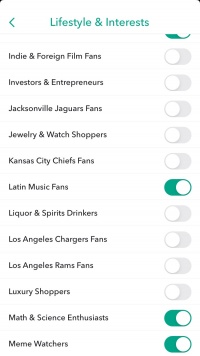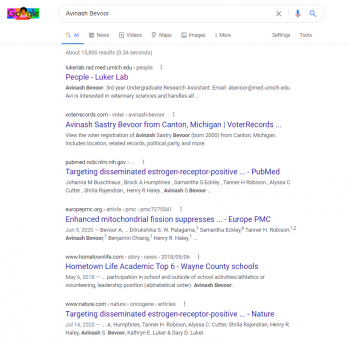Avinash Bevoor
For the most part, the data identity that I embody online is a caricature of my personal identity. While a google search of the name “Avinash Bevoor” brings up a number of links, the data that I have found collected on myself from a variety of sources paints a reflection of myself that is startlingly accurate in some ways and completely wrong in others.
Contents
Introduction
When first exploring the extent of my digital footprint, I began by searching my name in various search engines. This included the platforms of Google, Safari, and Bing. One problem with this approach that I ran into almost immediately was that my search results were already tailored to me, resulting in numerous articles appearing as the first few links. In order to circumvent this issue, I used incognito and private search modes in order to get a better understanding of what the average user would see when first searching my name. An additional problem that I ran into while searching for my identity using this method was that I would get different search results depending on the name I searched for. While a search for the name "Avinash Bevoor" would result in a list of articles that I was listed in and a link to my work profile, searching for my nickname, "Avi Bevoor", tended to show results for my social media pages.
Finally, in an effort to get a more in-depth understanding of my identity data, I also searched for my name on the various social media platforms I am active on. This included platforms such as Instagram, Snapchat, and TikTok, all of which displayed my profile as relatively accessible. In addition to this, I also looked at the personal data that specific platforms had collected on me. This included data collected by Facebook, Google, and TikTok, which could be downloaded from the individual websites.
Data Identity
Search Engines
From the results that appeared while searching for both my nickname and full name on a variety of search engines, I found the data to be surprisingly detailed and accurate. The first few links that appeared in my searches, which included public records and papers that I have published, all consisted of data that I had willingly released into the internet. One result that surprised me, however, was the voter record information that had a list of my name, address, and family members. In addition, I was shocked to find that the website that I had published for my 9th grade geography class was also still available to view.
However, despite the information that was available about me, when looking for any photos of myself through these search engines, no results were found.
Data Brokers
The information that was available on my identity through data brokers such as mylife.com was not nearly as comprehensive as the data available through search engines. While these sites managed to accurately report my name and hometown, there were no other information about me available. When looking at a list of my supposed family members and known associates the names that were displayed were ones that I had never seen before.
Social Media
The data that could be found on my social media pages was not much more explicit than any of the other methods of searching that I had used previously. Of the existing social media platforms that I use, I am not very active on any of them. In searching for myself on Instagram, Facebook, Snapchat, and TikTok, there was very little data that was publicly available to those who do not actively follow me on these sites. While photos of me were finally beginning to show up, these mainly included my profile picture and the one photo of myself that I had posted on my Instagram wall.
Compiled Identity
Google Dashboard
While the data that other people could find about me was relatively limited, the amount of data that was collected on my browsing habits on each of these sites was greater than I expected. After downloading the personal information that my google dashboard had collected on my identity, I found that it wasn't just my web history that was being tracked. In addition, Google had information concerning my work and home address, taken from google maps, as well as data on the number of emails in my Gmail inbox and the events in my phone calendar. I had previously considered that these apps might be collecting data on me individually, I did not realize that Google was using the data to generate a relatively accurate digital portrait of my identity. This is especially concerning in that even if I managed to stop using google search and google maps, many of my professional contacts are linked to Gmail, forcing me to retain some connection to the organization at all times.
Privacy policies
When diving further into the data that Google was collecting on me I found that the terms of privacy that I had agreed to much more invasive than what I had first imagined. One aspect of these privacy terms that shocked me was that even "when you’re not signed in to a Google Account, we store the information we collect with unique identifiers tied to the browser, application, or device you’re using". Other data they collect include device charge, contacts, and photos and videos that are saved on their various platforms as well as one 3rd party applications that use Google services.
Through this exploration, it has become evident that I am not nearly as invisible on the internet as I may believe. While the general public may not be able to find much more data on my identity more than the occasional article or post, Google itself has developed a very clear understanding of my real-world identity through my digital activity.
Digital Caricature
While sites like google have managed to collect accurate personal identity data, this is not always the case for other platforms. When browsing through the Lifestyles and Interests tab, which depicts the advertisement specifications that Snapchat assumes about its users, I found tabs such as “esports fan” and “Latin Music enthusiast” checked, two descriptions that do not match my identity at all. These same findings were reflected in the ad personalization tabs of TikTok as well.
These mixed results in my digital identity have led me to conclude that the persona that is created by the algorithms that collect personal data is more typically a caricature of a true person than a reflection. The data that is collected on an individual's browsing habits lends itself to a large amount of information. However, the algorithms that extrapolate a person's identity from this data are far from perfect. One possible reason for this is that multiple factors play a role in how users interact with individual sites. An example of this is the ads that I have received from eBay about buying a new guitar after buying a music stand for my friend. As a result, it is clear that people use different platforms for different purposes. This is especially true for social media platforms, which are often exclusively used for browsing or messaging rather than interacting with the entire site. However, because algorithms are limited by the information that is made available to them, incomplete data is used to create assumptions about users and their identities.
Overall, the data that is both publicly and privately collected about me is a mix of accurate observations and inaccurate assumptions. While I have attempted to control my digital identity to some level by keeping social media accounts private and regulating the information that I make available to the public, it is clear that users have almost no control over the way algorithms interpret the data they collect.


